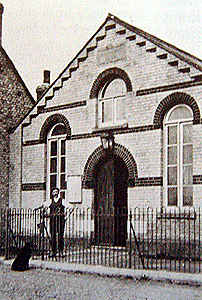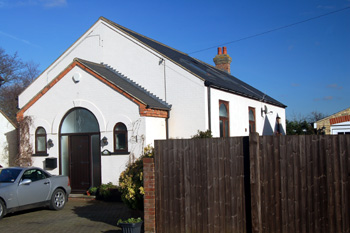Wesleyan Methodism in Greenfield

Greenfield chapel about 1900
The original chapel was built in 1840, but the first record we have of Wesleyan Methodism in Greenfield is in 1843 when the village is mentioned in the Dunstable Circuit stewards' account book [ref: MB343].
The chapel was first registered on 6th December 1845 by Wright Shovelton of Dunstable [refs: ABN1/2; ABN2/382]. It was registered again on 9th February 1854 by Matthew Trevan Male of Harpur Street, Bedford, superintendent minister.
In 1851 a religious census was held on Sunday 30th March. Every place of worship in the country holding services that day had to record numbers. Thomas Major, a local preacher from Toddington, sent in the return for Greenfield chapel. He noted that it had been built in 1840 and had sixty free sitting, fifty other seats and standing room for twenty. The general congregation in the afternoon had been ninety six and in the evening a hundred and six. The average for the six preceding months was eighty.
The chapel stood in Mill Lane, on the east side quite close to the junction with the High Street. There is a good short history of the chapel, by Wilf Dennis, the chapel keeper, in The Dunstable Methodist Circuit: One Hundred and Fifty Years of Witness 1843-1993 written by members of the circuit. The book is available on the Searchroom shelves. He tells the story of a possible ghost! "It is probably the only chapel in the Circuit credited with a ghost! Often I would shudder when I was unlocking the place. I would spread my hand over all four switches so that all the main lights came on at once! If you entered by the Sunday School door at the back, and just switched on two lights in the Sunday School, took a steady walk across the hall, opened the chapel door, there it was in the corner in the back seat, a white figure for all to see! I have seen older people cringe and children terrified when they saw it; put the lights on in the chapel, and it disappeared. On the other hand, if you left the lights off, and walked towards it, it slowly disappeared! Go and sit where it sat and you felt no ill effects! Often this wretched figure would almost make me tremble in my shoes! My explanation? – probably only harmless reflections! None the less there was one dear lady who lived nearby, when I spoke to her several years ago said: "I always closed my eyes when I passed that place, I always felt it was haunted".
In 1932 the Wesleyan Methodist joined with the United Methodist and Primitive Methodists to form the Methodist Church of Great Britain.
![The burnt out chapel [FSD/PC5]](/CommunityHistories/Greenfield/GreenfieldImages/The burnt out chapel [FSD-PC5].jpg)
The burnt out chapel [ref: FSD/PC5]
The chapel was destroyed by fire on 11th February 1962. The Ampthill News of 13th February reported: "The Methodist Chapel, Greenfield, was completely gutted by a fire which was discovered at 8.15 p. m., three-quarters-of-an-hour after the congregation had left, following the evening service on Sunday".
"Ampthill Brigade were the first to turn out, followed soon afterwards by tenders from Shefford and Bedford".
"At a conference by torch-light in the fire-blackened interior of the chapel surrounded by the charred remains of pews, Station Sub-Officer Alec Mann, of Ampthill, said that on his arrival the fire had seemed fiercest in the vicinity of the combustion stove".
"A member of the congregation, who wished to remain nameless, said that the stove had been examined before leaving and was "nearly out". She added: "There was a very high wind blowing which was shrieking in the pipe".
"The Chapel was built in 1840 as the Wesleyan Chapel. The inscription commemorating this has survived the fire".
"The roof is a total loss, together with the interior fittings. It is not yet known whether the walls can be built on again".
"It is likely that an appeal for a re-building fund will have to be considered" said the Rev. Alan Roberts, superintendent of the Dunstable Circuit as he stood in the fire-blackened building yesterday (Monday) morning".
"He said the chapel was insured, but it might not be for a sum adequate to cover re-building".
"Mr. W. G. Millard of School Lane, Greenfield, senior trustee, said he thought the insurance cover was £6,000. Fortunately the vestry has escaped damage, and the schoolroom, except for its roof. These were both later constructions than the main chapel".
"Mr. Will Justice, of Harlington, another trustee, said "Some provision will be made for services until we can rebuild". The trustees have not yet had time to consider what these arrangements will be".
The trustees minutes (ref: MB2/GRE/2/3100) record that on the 21 March 1962 the trustees resolved to renovate the Sunday School room and make it comfortable as a church. On 16 November a plan of the new chapel was present and accepted in principal. The trustees sanctioned the new building and accepted Mr Justice’s tender at their meeting of the 1st November 1963 however the minutes note the ‘major obstacle bricks a wait of 6 months.’ On 12 October 1964 they agreed to ask Mrs Kenworthy to open the new church. It was opened in November 1964 by the preacher who had conducted the last service in the old building.
In 2001 the trustees ‘with heavy heart’ adopted the option that ‘worship should cease and the church close…the final service will be held on Sunday November 25th'. Permission was granted for the chapel to be converted to residential use under a planning application submitted in February 2005. The old chapel was for sale in 2008. The particulars [ref: Z449/2/108] gave details of the accommodation as follows: an entrance lobby; a cloakroom; a study area measuring 15 feet 9 inches by 9 feet 8 inches; a dining area measuring 15 feet 9 inches by 12 feet 9 inches; a living area measuring 21 feet 8 inches by 17 feet 6 inches); a kitchen measuring 14 feet by 9 feet 5 inches; a family room measuring 10 feet 11 in by 8 feet 11 inches and a snug measuring 11 feet 7 inches by 9 feet 10 inches. The first floor contained three bedrooms, one of them en-suite, as well as a bathroom.
 The Old Chapel Mill Lane, February 2011
The Old Chapel Mill Lane, February 2011
List of sources at Bedfordshire Archives:
- MB2/GRE: Greenfield Methodist Chapel, Flitton (orginally Wesleyan)
- FSD/PC5: Bedfordshire Fire Service Photo Album, 1960-1963
- Z449/2/108: Sale particulars of The Old Chapel, Mill Lane, Greenfield, 2008